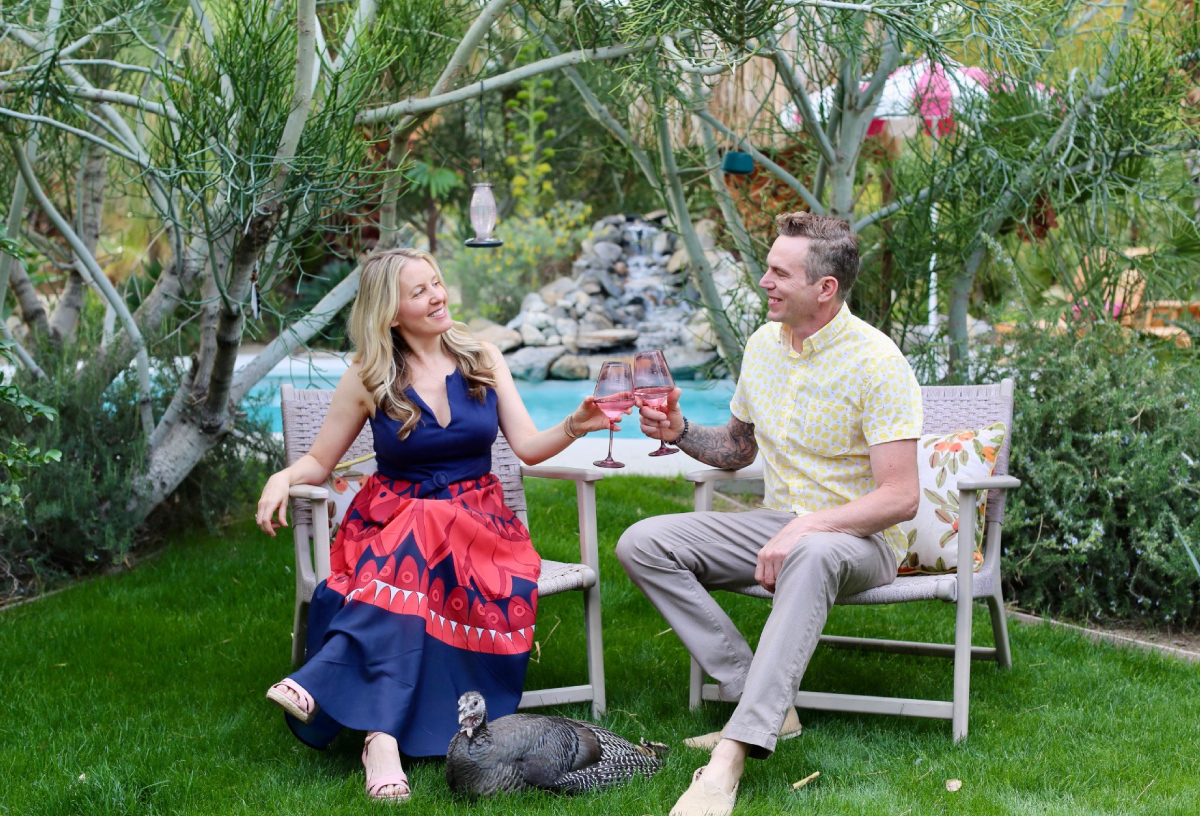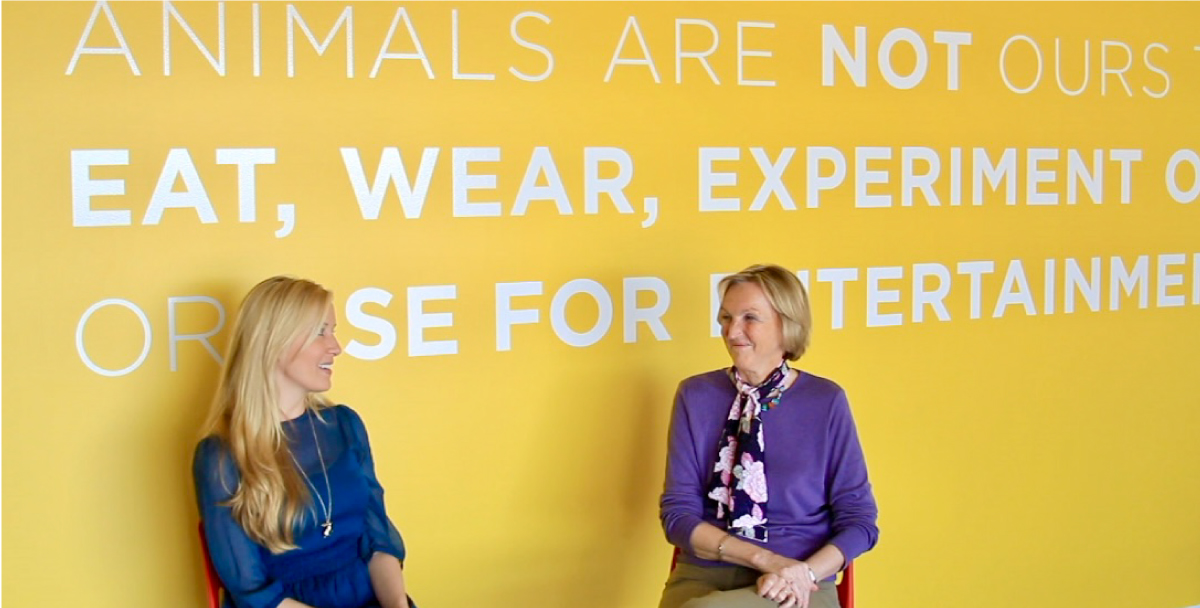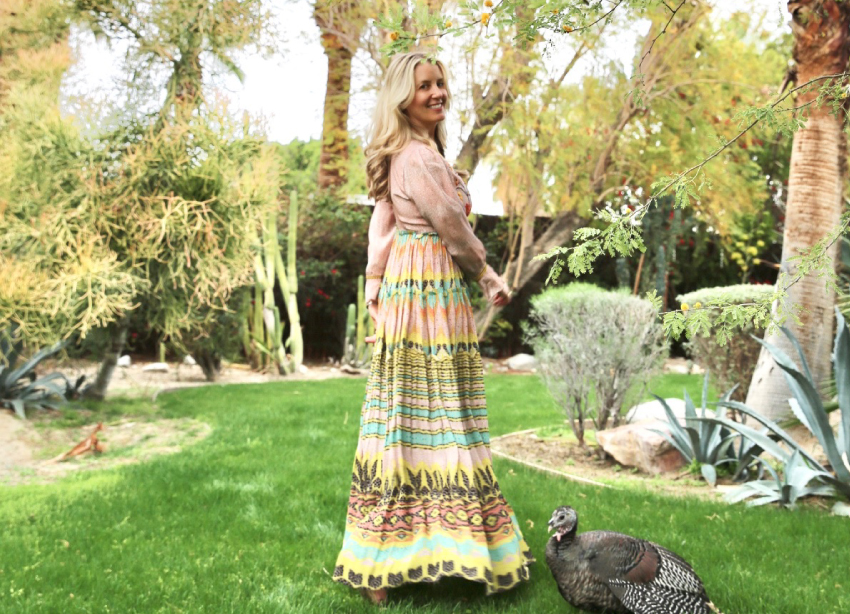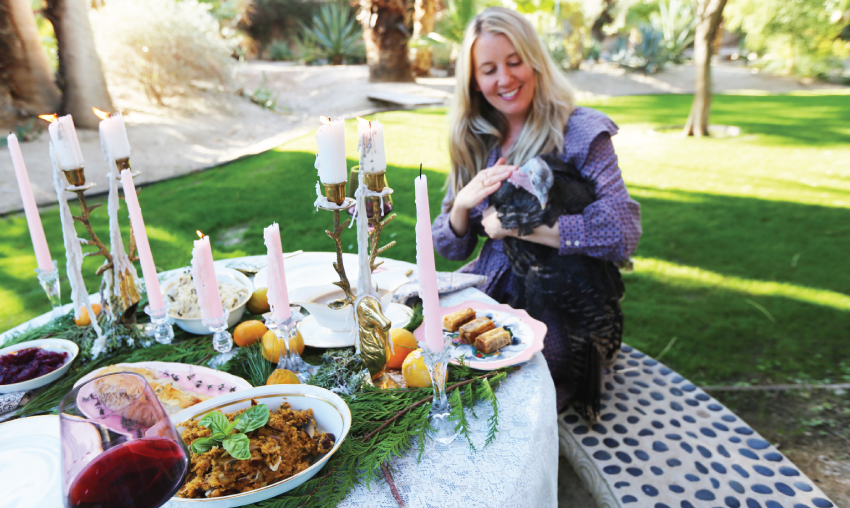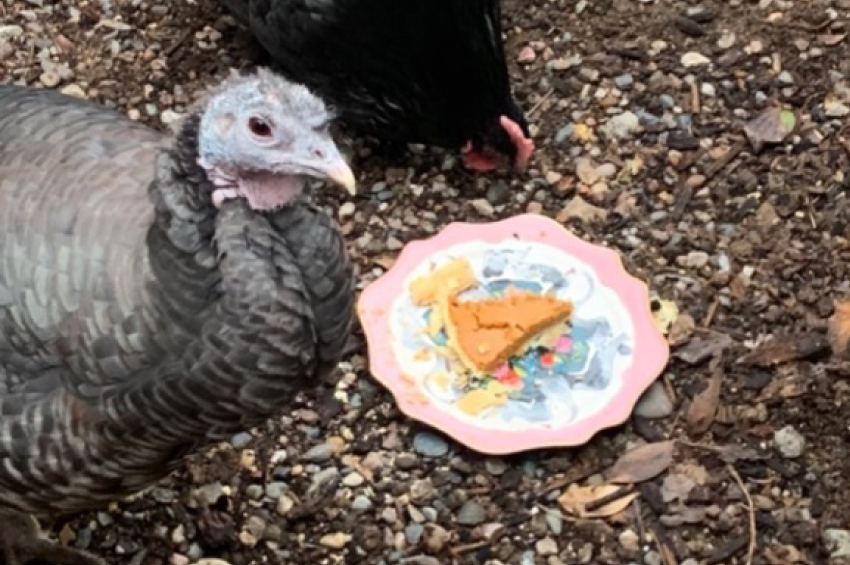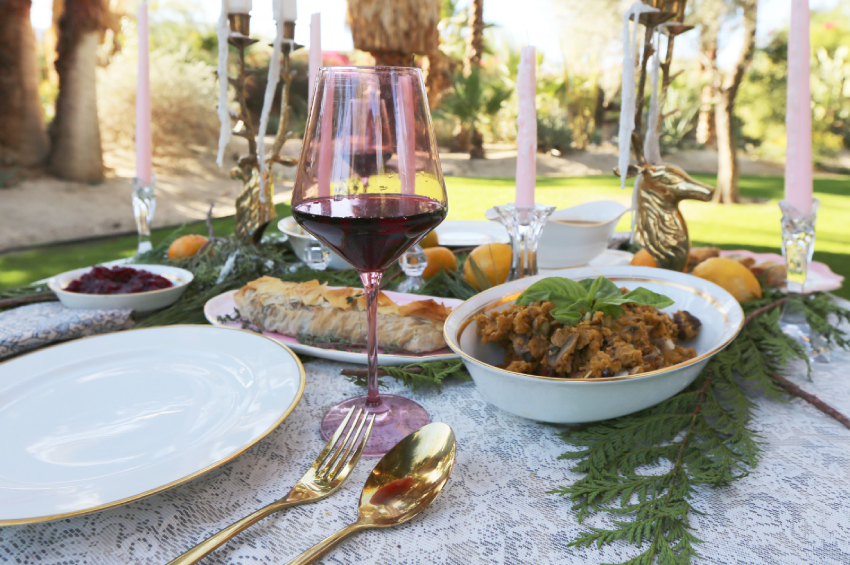More Than A Drumstick: How One Turkey Inspired A Kinder Thanksgiving
Fall marks the season of cozy vibes and comfort as the weather cools and we start to slow down. However, unfortunately, this season is not warm and fuzzy for everyone. Each year, close to 46 million turkeys are slaughtered for Thanksgiving alone. As one of the most intelligent birds in the avian kingdom, these highly social, brilliant sentient beings are full of curiosity and affection. We know these social birds are far more than a centerpiece at a holiday table – they’re sentient beings who deserve to live out their natural lives to the fullest.
How a Pet Turkey Came into My Life | A Journey Towards Animal Activism
Drumstick, my pet turkey, and her best friend, Bootsy, came into my life in 2016 when living in Topanga, a town in LA County once a magnet for artists in the 1960’s best known for its rolling hills and ample vegetation.
My partner, Sean Krejci, and I had been volunteering for years in LA as animal rescue volunteers, helping local animal rescue groups with weekend adoption events, dedicated to finding homeless dogs and cats forever homes. We became close with the animal activism and advocacy movement in LA and eventually began practicing a plant-based lifestyle and using our voices to speak up for furry and feathery creatures who did not have a voice and were at the hands of suffering.
Jessica Blotter volunteering with NKLA in Los Angeles
Jessica Blotter interviewing animal activist Bob Barker
This passion led us to interview celebrities and animal activists tied to Hollywood’s most prominent animal charity galas, including interviews with Bob Barker, Willie Nelson, Ian Somerhalder, and Paul Wesley, to the founders of animal welfare nonprofits (see Saving Circus Animals in Peru: Kind Traveler Interviews the Founders of Animal Defenders International) as we sought to shine a light on important animal welfare topics.
Related: Ian Somerhalder on Traveling Kindly, Saving Wildlife with WildAid
As we started to learn more and more about how animals were suffering on the planet – whether it be with farm animals, domestic animals, or wildlife facing extinction, our desires increased to get more involved with the movement. At this time in 2016, we were ending what was a four-year pre-launch phase of building Kind Traveler, which would launch in late 2016 as the first responsible travel platform to empower travelers to give back to the communities they visit through a network of hotel, charity, and destination partners.
Photo: Jessica Blotter interviewing Ingrid Newkirk, President of PETA
Our passion for giving back and creating a world where all beings were treated with kindness and equality led us to devote our lives to causes that were bigger than ourselves. This desire to unite our passions, purpose and skillsets drove us forward and became our guiding light -- during a time when kindness to animals, others and the environment was needed more than ever against a backdrop of war, violence and suffering.
The first time meeting Drumstick in Topanga
Photos: (L) The Gentle Barn LA (C) Animal Hero Kids Awards (R) Sean Krejci
The Day I Met Drumstick
Our neighbors in Topanga first introduced us to Drumstick and a flock of chickens they kept in a coop on their property, covered mainly by the shade of trees. I had never personally “met” a turkey or a chicken until this point, and within a few moments, our neighbor placed Drumstick in my arms (her name was already Drumstick before I met her). A little nervous at first, this docile creature felt like a warm bag of feathers, and I could feel she was instantly relaxed. I never knew turkeys could be so curious and accepting of other humans as she comfortably snuggled in the arms of a stranger.
A few months later, I found out that my neighbor could no longer take care of the birds and had placed a Craigslist ad to find new homes for these extraordinary beings. Having visited Drumstick on occasion, I developed a bond with her and could not fathom the consequences she may face should she be left to the unknowns of Craiglist. As we were no stranger to adopting animals rescued from death row thanks to our many ‘failed fostering’ attempts, happily leaving us with a feline family of six, adopting Drumstick and a chicken friend seemed like the kind thing to do.
A Life with Drumstick: Eight Years and Counting
We took the small flock in and built a beautiful A-frame-style coop in our yard. It’s been eight years since that day, and Drumstick and her chicken friend, Bootsy (thanks to her feathery ‘boots’ she dawns), have been by my side every day, now happily living on a half an acre in Palm Desert, our new home inspired by the pandemic.
Having spent almost every day for the last eight years with a pet turkey and chicken by my side, I feel a great deal of responsibility to share what I have learned about these remarkable creatures. By including facts and my life experience with these unique birds, I hope to offer a new perspective on our relationship with these intelligent beings to inspire a kinder way of giving thanks and celebrating the Thanksgiving holiday.
1. Why is it a U.S. tradition to eat turkey on Thanksgiving?
It’s not necessarily because the Pilgrims did it. According to Mental Floss, “The story of the first Thanksgiving has been mythologized in countless media, but concrete facts are limited. Almost all of the information historians have about the event comes from a letter written by Plymouth Plantation colonist Edward Winslow in December 1621. He wrote of a harvest feast the Pilgrims shared with the native Wampanoag people over three days in late autumn. The meal would have looked unfamiliar to people who associate Thanksgiving with green bean casserole, marshmallow-topped sweet potatoes, and pumpkin pie: Dishes on the menu included venison and wild fowl.”
It is argued that “wild fowl” could have just as likely meant ducks or geese.
2. The Thanksgiving Day holiday wasn’t a national holiday until the 19th century.
While the idea of giving thanks and celebrating the harvest was popular in certain parts of the country, it was by no means an annual national holiday until the 19th century.
3. In the US today, 99 percent of all farmed animals, including turkeys, live on factory farms.
A 2019 analysis from the USDA Census of Agriculture reflects that 99 percent of all farmed animals live on factory farms. The same study also cited that one animal-feeding operation can keep up to 55,000 turkeys. On an industrialized factory farm, the birds are packed in tightly together with little room to move around or express natural behaviors.
In the wild, turkeys might cover several miles before returning to roost at night.
4. Turkey farming is cruel: there are no federal laws to protect the welfare of turkeys raised for food in the US.
The vast majority spend their short lives in artificially lit, windowless, barren warehouse barns. So that turkeys won't peck one another in these crowded barns, their beaks and toes are painfully cut off with a hot blade without using any pain relievers. Some birds die from the painful shock of such procedures.
Yet there is no federal law that protects turkeys (or any other farmed animal) while being raised on factory farms. Source: 2019 Lewis & Clark Law School: Let’s Talk Turkey: The Law Fails to Provide Even Basic Protections to Birds Used for Food
5. 300 million turkeys are killed in factory farms each year in the US and are genetically modified to grow 3x larger than wild turkeys.
With no protection, they endure pain and harsh living conditions from the day they are born until they are killed. Because of their unnatural growth and genetic modification, they cannot reproduce naturally, as the males cannot successfully mount the females. Therefore, all turkeys raised in factory farms are born through artificial insemination.
While living in factory farms, some turkeys become crippled due to their weight and end up dying of starvation or dehydration because they are unable to reach their food and water. Other results of their unnatural growth include heart attacks, organ failures, severe pain, leg issues, and more. (Source: Piedmont Farm Animal Refuge: Factory Farming, Turkeys).
Photo Credit: East Bay Animal Advocates: “Free-range organic” young turkeys at Diestel Turkey Ranch with surgically mutilated beaks that will drop off leaving severely shortened upper beaks.
6. Turkeys create deep emotional bonds with other birds, animals and humans.
Drumstick’s ‘best friend’ is Bootsy, the chicken. They waddle around the yard all day, every day, together, nearly attached to the hip. They sleep side-by-side at night with each other in their coop and take naps together in the same way.
As cited on VegNews, Turkeys have incredible emotional intelligence, express empathy for other birds, form lasting social bonds, display affection, and even purr when they feel comforted.
When it comes to the turkey-human bond, female turkeys love to cuddle and form close relationships. Drumstick and Bootsy both love being cuddled and will come over to us and to strangers (when we have friends or family over to visit) and gladly nestle up to our feet, pose for a photo, sit in laps, and allow us to hold her. In all the eight years of my relationship with Drumstick, she’s never tried to nip or bite at me or anyone else. She’s always shown affection and love.
We’ve also seen Drumstick relax with our feline family! They all have free range in our yard and have learned to get along and respect each other’s boundaries.

